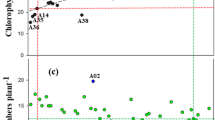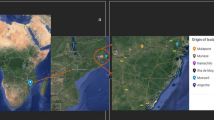Abstract
Aims
To investigate the succession of chickpea rhizobia over years and sampling sites.
Methods
Rhizobia were sampled four times from nodules of chickpea grown in four sites of Mulei County and Qitai County in Xinjiang, China during 2009–2016. The recA genes of rhizobia representing different populations were phylogenetically compared for their genotypic differentiation. Soil properties were examined to explore their hypothetical incidence on the rhizobial succession.
Results
The 628 isolates were all identified as Mesorhizobium muleiense, belonging to 28 genotypes distinguished by recA phylogeny. For each site, 15, 17, 10 and 7 genotypes were detected during the whole sampling period; while 4, 15, 12 and 17 genotypes were evidenced in each of the 4 sampling years (2009, 2013, 2015 and 2016) from all the four sites. Four major genotypes (T12 through T15) were found throughout the four years in the four sites at various frequencies. While the other genotypes were site and/or year specific. Both increased genetic diversity as revealed by Shannon-Weaver index and shifts in the population composition as revealed by genotyping were detected in the chickpea rhizobial populations during the study period. Nitrogen content, available phosphorus and potassium, and pH were the main factors correlated to the genotype distribution of chickpea rhizobia in the soil over years.
Conclusions
The genetic diversity of M. muleiense increased and the population composition shifted over years and at different sampling sites. The recA gene is an adequate molecular marker to estimate the intraspecific variation and succession of M. muleiense genotypes. The rhizobial genotype succession/evolution in the fields might be driven by the fluctuations of soil characteristics like nitrogen content, available phosphorus and potassium, and pH.




Similar content being viewed by others
References
Alexandre A, Brigido C, Laranjo M, Rodrigues S, Oliveira S (2009) Survey of chickpea rhizobia diversity in Portugal reveals the predominance of species distinct from Mesorhizobium ciceri and Mesorhizobium mediterraneum. Microb Ecol 58:930–941
Armas-Capote N, Perez-Yepez J, Martinez-Hidalgo P, Garzon-Machado V, Del Arco-Aguilar M, Velazquez E, Leon-Barrios M (2014) Core and symbiotic genes reveal nine Mesorhizobium genospecies and three symbiotic lineages among the rhizobia nodulating Cicer canariense in its natural habitat (La Palma, Canary Islands). Syst Appl Microbiol 37:140–148
Atlas RM, Bartha R (2001) Ecologıa Microbiana y Microbiologıa Ambiental (Spanish version of the 4th edn). Addison Wesley, Madrid, p 696
Braak C, Smilauer P (2002) CANOCO reference manual and CanoDraw for Windows user’s guide: sofware for canonical community ordination (version 4.5). Section on permutation methods microcomputer power, Ithaca, Newyork
Cao Y, Wang ET, Zhao L, Chen WM, Wei GH (2014) Diversity and distribution of rhizobia nodulated with Phaseolus vulgaris in two ecoregions of China. Soil Biol Biochem 78:128e137
Diaz Caballero J, Clark ST, Coburn B, Zhang Y, Wang PW, Donaldson SL, Tullis DE, Yau YC, Waters VJ, Hwang DM, Guttman DS (2015) Selective sweeps and parallel Pathoadaptation drive Pseudomonas aeruginosa evolution in the cystic fibrosis lung. mBio 6:e00981–e00915. https://doi.org/10.1128/mBio.00981-15
Duodu S, Nsiah EK, Bhuvaneswari TV, Svenning MM (2006) Genetic diversity of a natural population of Rhizobium leguminosarum biovar trifolii analysed from field nodules and by a plant infection technique. Soil Biol Biochem 38(5):1162–1165
Duodu S, Carlsson G, Huss-Danell K, Svenning MM (2007) Large genotypic variation but small variation in N2 fixation among rhizobia nodulating red clover in soils of northern Scandinavia. J Appl Microbiol 102:1625–1635
Fierer N, Jackson RB (2006) The diversity and biogeography of soil bacterial communities. Proc Natl Acad Sci U S A 103:626–631
Han L, Wang E, Han T, Liu J, Sui X, Chen W (2009) Unique community structure and biogeography of soybean rhizobia in the saline-alkaline soils of Xinjiang, China. Plant Soil 324:291–305
Harrison S, Young JPW, Jones DG (1987) Rhizobium population genetics: effect of clover variety and inoculum dilution on the genetic diversity sampled from natural populations. Plant Soil 103:147–150
Javaid AM, Muhammad K, Amer J (2011) Screening of Mesorhizobium ciceri isolates from rainfed area for improvement in growth and nodulation of chickpea seedlings under controlled conditions. Soil and. Environment 30:160–165
Jukanti AK, Gaur PM, Gowda CL, Chibbar RN (2012) Nutritional quality and health benefits of chickpea (Cicer arietinum L.): a review. Br J Nutr 108(Suppl 1):S11–S26
Leps J, Smilauer P (2003) Multivariate analysis of ecological data using CANOCO. Cambridge University Press, Cambridge, UK
Li QQ, Wang ET, Zhang YZ, Zhang YM, Tian CF, Sui XH, Chen WF, Chen WX (2011) Diversity and biogeography of rhizobia isolated from root nodules of glycine max grown in Hebei Province, China. Microb Ecol 61:917–931
L'Taief B, Sifi B, Gtari M, Zaman-Allah M, Lachaal M (2007) Phenotypic and molecular characterization of chickpea rhizobia isolated from different areas of Tunisia. Can J Microbiol 53:427–434
Nandwani R, Dudeja SS (2009) Molecular diversity of a native mesorhizobial population of nodulating chickpea (Cicer arietinum L.) in Indian soils. J Basic Microbiol 49:463–470
Nour SM, Cleyet-Marel JC, Beck D, Effosse A, Fernandez MP (1994) Genotypic and phenotypic diversity of Rhizobium isolated from chickpea (Cicer arietinum L.) Can J Microbiol 40:345–354
Nour SM, Cleyet-Marel JC, Normand P, Fernandez MP (1995) Genomic heterogeneity of strains nodulating chickpeas (Cicer arietinum L.) and description of Rhizobium mediterraneum sp. nov. Int J Syst Bacteriol 45:640–648
Odair A, Glaciela K, Mariangela H (2006) Sampling effects on the assessment of genetic diversity of rhizobia associated with soybean and common bean. Soil Biol Biochem 38(6):1298–1307
R Core Team (2017) R: a language and environment for statistical computing. R Foundation for Statistical Computing, Vienna, Austria URL https://www.R-project.org/
Rai R, Dash PK, Mohapatra T, Singh A (2012) Phenotypic and molecular characterization of indigenous rhizobia nodulating chickpea in India. Indian J Exp Biol 50:340–350
Rivas R, Laranjo M, Mateos PF, Oliveira S, Martinez-Molina E, Velazquez E (2007) Strains of Mesorhizobium amorphae and Mesorhizobium tianshanense, carrying symbiotic genes of common chickpea endosymbiotic species, constitute a novel biovar (ciceri) capable of nodulating Cicer arietinum. Lett Appl Microbiol 44:412–418
Romdhane BS, Tajini F, Trabelsi M, Aouani ME, Mhamdi R (2007) Competition for nodule formation between introduced strains of Mesorhizobium ciceri and the native populations of rhizobia nodulating chickpea (Cicer arietinum L.) in Tunisia. World J Microbiol Biotechnol 23:1195–1201
Rupela OP, Sudarshana MR (1990) Displacement of native rhizobia nodulating chickpea (Cicer arietinum L.) by an inoculant strain through soil solarization. Biol Fertil Soils 10:207–212
Scholz HC, Witte A, Tomaso H, Dahouk SA, Neubauer H (2005) Genotyping of Chromobacterium violaceum isolates by recA PCR-RFLP analysis. FEMS Microbiol Lett 244:347–352
Scholz HC, Tomaso H, Dahouk SA, Witte A, Schloter M, Kampfer P, Falsen E, Neubauer H (2006) Genotyping of Ochrobactrum anthropi by recA-based comparative sequence, PCR-RFLP, and 16S rRNA gene analysis. FEMS Microbiol Lett 257:7–16
Singh F, Diwakar B (eds) (1995) Chickpea botany and production practices. ICRISAT Training andFellowships Program Patancheru 502 324, Andhra Pradesh, India
Singh RP, Manchanda G, Singh RN, Srivastava AK, Dubey RC (2016) Selection of alkalotolerant and symbiotically efficient chickpea nodulating rhizobia from north-west indo Gangetic Plains. J Basic Microbiol 56:14–25
Somasegaran P, Bohlool BB (1990) Single-strain versus multistrain inoculation: effect of soil mineral N availability on rhizobial strain effectiveness and competition for nodulation on chickpea, soybean, and dry bean. Appl Environ Microbiol 56:3298–3303
Suleiman AKA, Manoeli L, Boldo JT, Pereira MG, Roesch LFW (2013) Shifts in soil bacterial community after eight years of land-use change. Syst Appl Microbiol 36:137–144
Tamura K, Stecher G, Peterson D, Filipski A, Kumar S (2013) MEGA6: molecular evolutionary genetics analysis version 6.0. Mol Biol Evol 30:2725–2729
Tena W, Wolde-Meskel E, Degefu T, Walley F (2017) Genetic and phenotypic diversity of rhizobia nodulating chickpea (Cicer arietinum L.) in soils from southern and central Ethiopia. Can J Microbiol 63:690–707
Terefework Z, Kaijalainen S, Lindstrom K (2001) AFLP fingerprinting as a tool to study the genetic diversity of Rhizobium galegae isolated from Galega orientalis and Galega officinalis. J Biotechnol 91:169–180
Van Cauwenberghe J, Lemaire B, Stefan A, Efrose R, Michiels J, Honnay O (2016) Symbiont abundance is more important than pre-infection partner choice in a Rhizobium-legume mutualism. Syst Appl Microbiol 39(5):345–349
Vincent JM (1970) A manual for the practical study of rootnodule bacteria. International Biological Programme, Blackwell, Oxford
Wei G, Chen W, Zhu W, Chen C, Young JPW, Bontemps C (2009) Invasive Robinia pseudoacacia in China is nodulated by Mesorhizobium and Sinorhizobium species that share similar nodulation genes with native American symbionts. FEMS Microbiol Ecol 68:320–328
Zhang JJ, Liu TY, Chen WF, Wang ET, Sui XH, Zhang XX, Li Y, Li Y, Chen WX (2012a) Mesorhizobium muleiense sp. nov., nodulating with Cicer arietinum L. Int J Syst Evol Microbiol 62:2737–2742
Zhang JJ, Lou K, Jin X, Mao PH, Wang ET, Tian CF, Sui XH, Chen WF, Chen WX (2012b) Distinctive Mesorhizobium populations associated with Cicer arietinum L. in alkaline soils of Xinjiang, China. Plant Soil 353:123–134
Zhang YM, Li Y, Chen WF, Wang ET, Tian CF, Li QQ, Zhang YZ, Sui XH, Chen WX (2011) Biodiversity and biogeography of rhizobia associated with soybean plants grown in the North China Plain. Appl Environ Microbiol 77:6331–6342
Zhang JJ, Yu T, Lou K, Mao PH, Wang ET, Chen WF, Chen WX (2014) Genotypic alteration and competitive nodulation of Mesorhizobium muleiense against exotic chickpea rhizobia in alkaline soils. Syst Appl Microbiol 37:520–524
Zhang JJ, Yang X, Guo C, de Lajudie P, Singh RP, Wang ET, Chen WF (2017) Mesorhizobium muleiense and Mesorhizobium gsp. nov. are symbionts of Cicer arietinum L. in alkaline soils of Gansu, Northwest China. Plant Soil 410:103–112
Acknowledgements
This work was financed by the National Natural Science Foundation of China (Project No. 31400008, 11575149 and 31571778), National human and social security ministry of science and technology for overseas returnees (Project No. 21104000005) and the Scientific Research Funds of Zhengzhou University of Light Industry (Project No. 2014bsjj006). Entao Wang is financially supported by grants SIP20171259 authorized by Instituto Politécnico Nacional, Mexico. Wenfeng Chen was supported financially from State Key Laboratory of Agrobiotechnology (2017SKLAB7-1).
Author information
Authors and Affiliations
Corresponding authors
Additional information
Responsible Editor: Euan K. James
Rights and permissions
About this article
Cite this article
Zhang, J., Guo, C., Chen, W. et al. Dynamic succession of chickpea rhizobia over years and sampling sites in Xinjiang, China. Plant Soil 425, 241–251 (2018). https://doi.org/10.1007/s11104-018-3586-9
Received:
Accepted:
Published:
Issue Date:
DOI: https://doi.org/10.1007/s11104-018-3586-9




